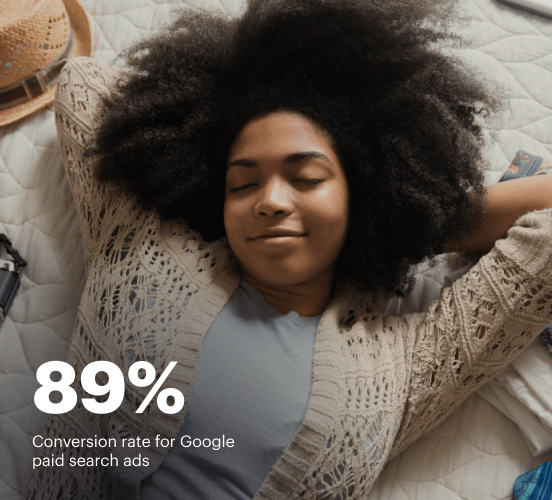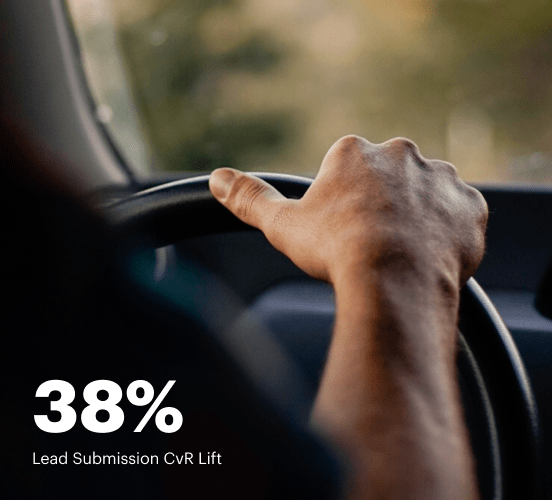How Paperform vs. Adobe Target vs. Instapage stack up against each other
Compare Instapage with Paperform and Adobe Target to create high-converting landing pages. With personalization, optimization, and collaboration tools, Instapage helps you deliver experiences that drive results.
Get startedSee how Instapage stacks up against the competition
| Feature | Instapage | Other builders |
| Drag-and-Drop Tools | ||
| Conversion-optimized templates | ||
| Manual and AI-powered A/B Tests | ||
| AI content suggestions | ||
| Popups and sticky bars | ||
| Canvas and grid blocks | ||
| Reusable and global elements | ||
| Form and popup builders | ||
| Built-in Heatmaps | ||
| Central analytics dashboard | ||
| Ad-to-page personalization and collections | ||
| Contacts, lists, and email | ||
| Dedicated, full-service CRO experts | ||
| Enterprise-ready platform |
Leading the way in building high-performing landing pages





Why Instapage is the smarter choice for your campaigns
Get everything you need to build, scale, and optimize high-converting landing pages—without coding.

Easier page building without coding
Instapage offers a flexible and seamless page creation experience with a library of 500+ conversion-focused layouts, Instablocks®, a drag-and-drop builder, and AI content generation. With technologies like Thor Render Engine®, you can create on-brand, mobile-responsive landing pages that load quickly and start converting during initial visitor clicks.

More insights — better results
Instapage lets you see in detail how each landing page experience and variation is performing so you can make targeted changes that boost page conversions. Use heatmaps for a better understanding of on-page activities, run A/B tests and AI-assisted experiments, and then track and evaluate results within robust analytics dashboards.

More personalized experiences
Instapage lets you quickly create high-performing landing pages tailored to each of your ad campaigns. Deliver personalized experiences for distinct audiences using dynamic text replacement. Effortlessly align specific advertisements to unique pages with AdMaps. Monitor audience-level metrics using our advanced data tools.

Built-in collaboration
Instapage collaboration capabilities bring your entire team together to speed up the process of landing page review, approval, and launch. No more frustrating and unnecessary revisions or edits scattered across emails. Provide instant feedback, conduct real-time page edits, and securely share your pages with outside stakeholders.

Free up time for your business
Invest time into business growth, not busy work. Launch landing pages faster with reusable forms and templates. Build once, reuse forever.
Explore all integrations






Easier page building without coding
Instapage offers a flexible and seamless page creation experience with a library of 500+ conversion-focused layouts, Instablocks®, a drag-and-drop builder, and AI content generation. With technologies like Thor Render Engine®, you can create on-brand, mobile-responsive landing pages that load quickly and start converting during initial visitor clicks.
More insights — better results
Instapage lets you see in detail how each landing page experience and variation is performing so you can make targeted changes that boost page conversions. Use heatmaps for a better understanding of on-page activities, run A/B tests and AI-assisted experiments, and then track and evaluate results within robust analytics dashboards.
More personalized experiences
Instapage lets you quickly create high-performing landing pages tailored to each of your ad campaigns. Deliver personalized experiences for distinct audiences using dynamic text replacement. Effortlessly align specific advertisements to unique pages with AdMaps. Monitor audience-level metrics using our advanced data tools.
Built-in collaboration
Instapage collaboration capabilities bring your entire team together to speed up the process of landing page review, approval, and launch. No more frustrating and unnecessary revisions or edits scattered across emails. Provide instant feedback, conduct real-time page edits, and securely share your pages with outside stakeholders.
Free up time for your business
Invest time into business growth, not busy work. Launch landing pages faster with reusable forms and templates. Build once, reuse forever.
Explore all integrationsGet started with Instapage in a few steps
-
Create your Instapage account
Start with Instapage by signing up via Google or your email. You'll get access to a free 14-day trial to discover Instapage capabilities. Feel free to cancel anytime during the 14-day trial if you decide that our product is not suitable for your business. -
Build and personalize your page
Create your first landing page from scratch or choose a template from 500+ customizable layouts. Use the drag-and-drop builder to add page elements, fonts, and backgrounds, refine content with AI, or add custom HTML, Javascript, and CSS. -
Review and make edits
Collaborate on page designs and streamline review processes. Invite your team members and stakeholders to review, edit, and provide feedback on your landing page. Collaborate knowing your page is confidential and only accessible to authorized users. -
Publish and track page performance
Publish your page to a domain or custom URL. Connect your pages to the ads you've created and track page performance within the analytics dashboard, run A/B tests and AI experiments, analyze results, and continuously optimize your landing page to maintain high conversions.
Instapage vs. Paperform vs. Adobe Target – A Confrontation of the Landing Page Builders
Choosing the right landing page builder can feel as critical as assembling a winning sports team. Each tool has its distinct skills and attributes that can amplify your marketing efforts. In this article, we will explore the unique offerings of Instapage, Paperform, and Adobe Target, to see how they stand up to the challenges faced by marketers today. By the end, you will understand not only the strengths and weaknesses of each tool, but how Instapage, in particular, empowers marketers to cut costs, enhance conversion rates, and craft personalized landing page experiences that establish brand loyalty and trust with customers. We’ll go beyond mere comparison; we will look at how these platforms can elevate your campaign strategy, making the process of conversion seamless and effective. Each platform has its flair, but in a world where customer engagement is paramount, let's discover which tool takes the crown.
Meet the Competitors: Who’s Who in the Digital Arena
Let’s put the spotlight on our three contenders, each representing a unique approach to landing page creation. Instapage is recognized for its robust features designed specifically for marketers, aiming to create high-converting landing pages that engage visitors from the get-go. Paperform positions itself as a versatile tool allowing users to create forms, surveys, and landing pages with remarkable ease of use, making it a popular choice for small businesses and solopreneurs. Meanwhile, Adobe Target, a stalwart in the world of digital marketing solutions, is geared toward large enterprises, focusing on personalized content delivery and A/B testing features. As we delve into the features, usability, and support offered by these platforms, we aim to give you a well-rounded understanding of their capabilities and how they can influence your marketing results. While each tool is distinct, they all cater to the ever-increasing need for engaging and effective landing page solutions in today’s fast-paced environment.
Round One: Feature Showdown - What’s in the Toolbox?
Diverse Templates and User-Friendliness: A Comparison
Exploring the key features of each platform reveals a wealth of options for marketers looking to streamline their landing page development. Instapage boasts an impressive library of over 500 customizable templates that cater to various industries and campaign goals. Its user interface is intuitive, ensuring that even those without technical skills can create stunning pages in a matter of minutes. In contrast, Paperform's appeal lies in its simplicity. Not just limited to landing pages, it serves as a powerful form builder that integrates seamlessly into your websites and marketing efforts. The platform offers beautiful templates that can be customized and styled to match brand aesthetics, making them ideal for creative businesses. Adobe Target, on the other hand, emphasizes personalization and testing. While its template library might not be as extensive, its strength lies in its robust A/B testing features that allow marketers to tailor pages based on user behavior, optimizing the customer journey continuously. Each platform offers unique features, but the choice ultimately boils down to individual business needs and ease of use.
Instapage: The Conversion Optimization Powerhouse
When it comes to conversion rate optimization, Instapage sets itself apart with tools designed not just to attract visitors, but to convert them into customers effectively. The platform's standout features include its advanced A/B testing capabilities, which provide actionable insights into visitor behavior, enabling marketers to fine-tune their campaigns based on real-world data. Furthermore, its seamless integration with major marketing tools allows for a holistic approach to customer engagement. Instapage empowers marketers to experiment with different elements like headlines, calls-to-action, and multimedia to optimize pages for higher conversions. The user-friendly drag-and-drop editor makes customization accessible, while the comprehensive analytics dashboard provides in-depth performance tracking. In a landscape where brand trust and customer loyalty are paramount, Instapage ensures marketers can create relevant landing page experiences that resonate with target audiences, ultimately leading to increased conversion rates.
Round Two: Speed and Performance – The Race to the Finish
After setting the stage, let us engage our readers in a light metaphor about website speed. Picture yourself in line at a busy coffee shop, waiting eagerly for your favorite brew. If the barista takes too long, your excitement dwindles, and you might just walk out. The same applies to landing pages; slow loading times can have a detrimental effect on user experience, leading to potential bounce rates that can break a marketer's heart. When comparing the speed and performance of Instapage, Paperform, and Adobe Target, it's critical to assess how swiftly they deliver landing page experiences to users. Each platform approaches speed in a unique manner, but let’s break down what they bring to the table.
Advantages of Instapage in Speed & Performance:
- Optimized loading speed that enhances user experience.
- Technical performance is boosted through smart caching systems.
- Supports AMP (Accelerated Mobile Pages) for rapid mobile loading.
- Integration with CDNs (Content Delivery Networks) ensures global accessibility.
Advantages of Paperform in Speed & Performance:
- Simple forms and landing pages load quickly because of streamlined code.
- User-friendly interface reduces load time for creators and visitors.
- Effective image compression ensures that visuals don’t hinder performance.
Advantages of Adobe Target in Speed & Performance:
- Powerful server-side processing allows for quick personalizations.
- A/B testing features are designed to run with minimal delay.
- Optimized for performance in large-scale campaigns, ensuring fast content delivery.
- Integrates with other Adobe products for enhanced speed and efficiency.
In conclusion, when it comes to speed and performance, each landing page builder has its merits to consider. Instapage emerges as a front-runner, especially with its focus on loading speeds and overall performance metrics, making it ideal for marketers who prioritize user experience. Paperform also has a commendable track record regarding simplicity and effectiveness, while Adobe Target thrives in enterprise-level applications where quick personalizations are crucial. Ultimately, the choice depends on your specific needs, but Instapage certainly stands out in this round.
Round Three: Exploring Usability and Learning Curves
Navigating new software can sometimes feel like learning a foreign language, but this doesn’t have to be the case here. Each platform welcomes both beginners wanting to dip their toes into the world of landing page creation and seasoned professionals looking for advanced options. Instapage features a design that is intuitive, ensuring that users, regardless of their expertise, find the learning process straightforward. Its onboarding resources, including tutorials and support documentation, are extensive and helpful. Paperform is equally welcoming; its ability to create forms and landing pages in one interface speaks volumes to newcomers. The customization options may take a little time to master, but ultimately make the building process smooth and enjoyable. Adobe Target draws in users through its robust feature set, but may present a steeper learning curve, particularly for those unfamiliar with technical marketing jargon. However, once mastered, it offers powerful tools for enterprise clients intent on personalization and customer journeys. Overall, the platforms ensure a supportive environment for users to develop their skills and achieve their marketing goals effectively.
Round Four: The Support Team – Who’s Got Your Back?
Each of our contenders boasts a dedicated support team, ready to assist, akin to loyal sidekicks eager to help resolve queries and challenges. Instapage shines with 24/7 live chat support, ensuring users have access to assistance whenever they need it. Comprehensive knowledge bases and community forums also provide extensive self-help resources, enhancing the user experience. Paperform similarly offers responsive email support, coupled with guides and resources aimed at easing user navigation. Noteworthy is their active community, where users often share tips, tricks, and solutions. On the other hand, Adobe Target presents a wealth of resources geared towards large enterprises, including priority support options and a detailed help center. Their dedicated account managers for enterprise clients provide tailored assistance, ensuring organizations achieve their marketing goals efficiently. User experience is a priority for all platforms, and effective support is crucial in ensuring customers feel valued and empowered.
Round Five: A Look at Pricing – Balancing Value and Budget
When it comes to pricing, clarity is essential. Instapage tends to operate on a subscription model, offering plans that cater to various business sizes, from startups to large enterprises. The comprehensive features offered justify the investment, especially for businesses focused on conversion optimization. Paperform takes a slightly different approach, charging based on the number of forms created, making it highly cost-effective for small businesses. Their flexible pricing structure allows users to pay according to their needs, which can be extremely beneficial for seasonal campaigns. Adobe Target pricing is best suited for larger enterprises looking for robust personalization features and extensive analytics. The initial investment is considerable, but for businesses that require high-level customization and integration with other Adobe products, the return can be substantial. Understanding your specific goals and budget is vital when determining which platform provides the best value for your endeavors.
In conclusion, while each platform presents unique strengths, it is vital to choose the one that aligns best with your marketing needs and budget. The right landing page tool should not only provide a robust feature set but also align with the overall objectives of your campaign. As you weigh your options, don’t forget that Instapage offers a free trial, making it easy to test its capabilities before committing. Ultimately, the decision of which platform suits your needs will boil down to what features, support, and pricing strategy you value most. Happy landing page building!










